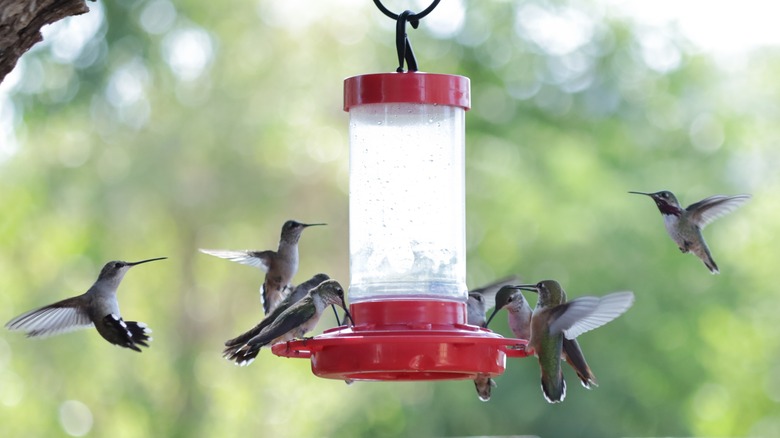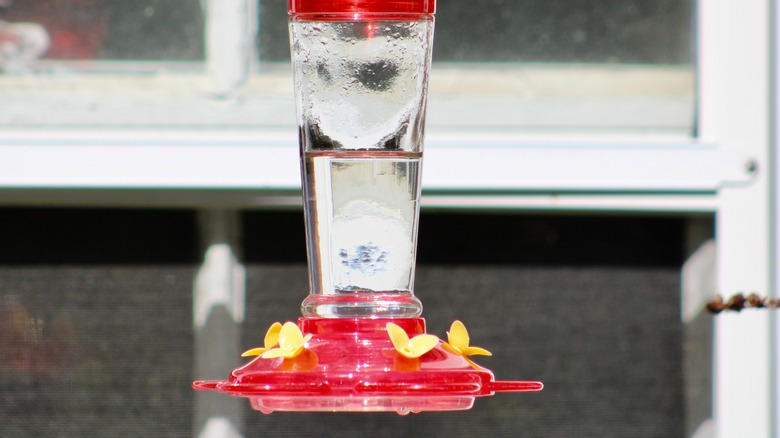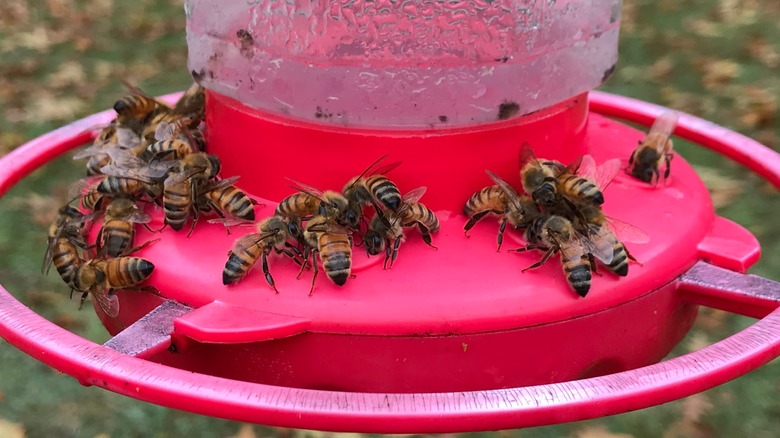Don't Make The Mistake Of Putting Your Hummingbird Feeder In The Wrong Spot
When attracting and feeding hummingbirds, the last thing you want to do is expose them to potential harm because of where you've hung your feeder. There are a few places you definitely want to avoid when finding the perfect placement to feed and keep these little guys safe (while still giving you a lovely view of these fascinating friends!).
Feeders hung in the sunshine can become spoiled or too hot, which can hurt or even kill hummingbirds. While not so noxious, other factors make spots unappealing to the hummingbirds too, such as areas with high traffic or close proximity to other bird feeders, and areas with competition from bees or nearby flowers. It may seem like you're left with few options for healthy hummingbird feeding, yet all is not lost. Hung in the right spot, your feeder can attract hummingbirds to your garden for years. Here's what to keep in mind.
Avoid these areas for your hummingbird feeder
To transform your yard into a hummingbird haven, steer clear of putting feeders in a few risky spots. Be cautious and hang your feeder at least 3 feet away from windows. Hitting windows is one of the main causes of bird deaths. Birds see their reflections or the reflection of the sky and fly towards it, and the impact can leave many creatures permanently injured or dead. Their reflections can also frighten them away.
Providing a densely shaded perch for the birds to relax on can also seem like a good idea. However, if your feeder is too close to thick brush or leaves, you're putting your feathered guests at the risk of attack. Scouting out a spot with minimal hiding spaces for hungry hunters like cats and prey is the best bet — hang feeders 10 feet or more away from thick foliage.
Problems with their nectar can be deadly too. Find a spot for the feeder that's not in direct sun all day, though partial shade with a limited amount of direct sunlight is okay. In hot weather, nectar can spoil within just a few days. Moldy, bacteria-laden nectar can cause birds to contract illnesses like avian poxvirus and salmonellosis. Also, the small containers baking in the sun can heat the food to temperatures that are harmful. Researchers have found that when hummingbirds eat nectar heated to 102 degrees Fahrenheit, it causes unhealthy spikes in their metabolic rates.
Other feeder location factors to consider
There are a few more errors you don't want to make with your hummingbird feeder. Hummingbirds startle easily, and there are a handful of preventative measures you can take to limit their frights. Avoid spots like sidewalks or other locales that get lots of traffic. Bees also find sugary nectar delectable, so if you're aware of a nearby hive, hang your feeder 20 to 30 feet from active ones. If you still get unwanted bee activity, many bird feeder companies market bee guards that go over the feeding ports, blocking the bees' access but not the birds'.
If you can, choose a spot that's not too close to other types of bird feeders, since larger birds can frighten smaller birds away. Nearby flowering plants can make your yard appealing to hummingbirds, but if they're too close to the feeder, they're likely to opt for the real deal over your nectar. If your feeder is 10 to 15 feet away from tasty flowers, they're more apt to eat at your feeder.


